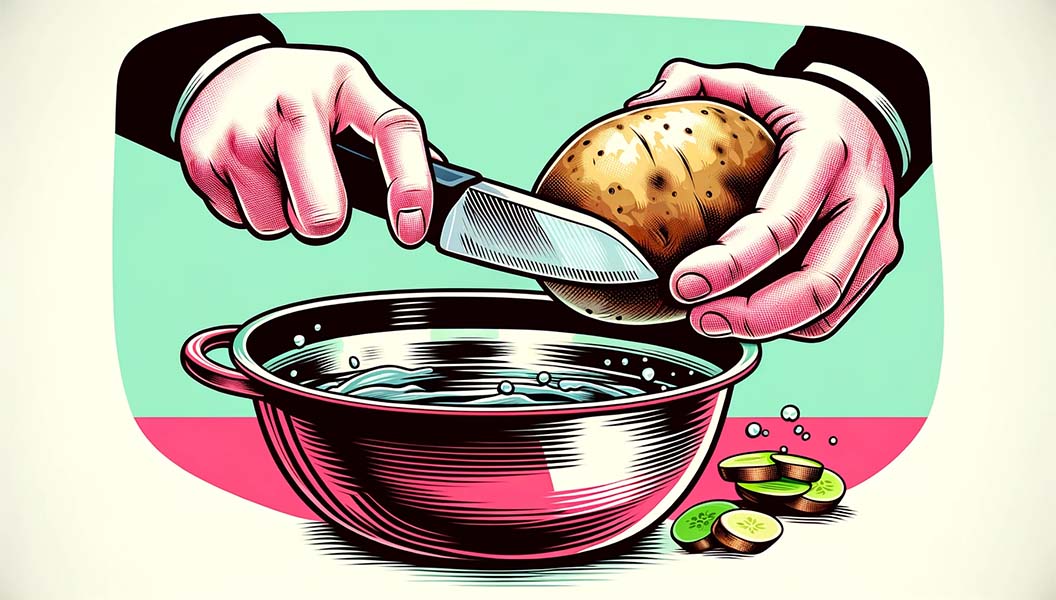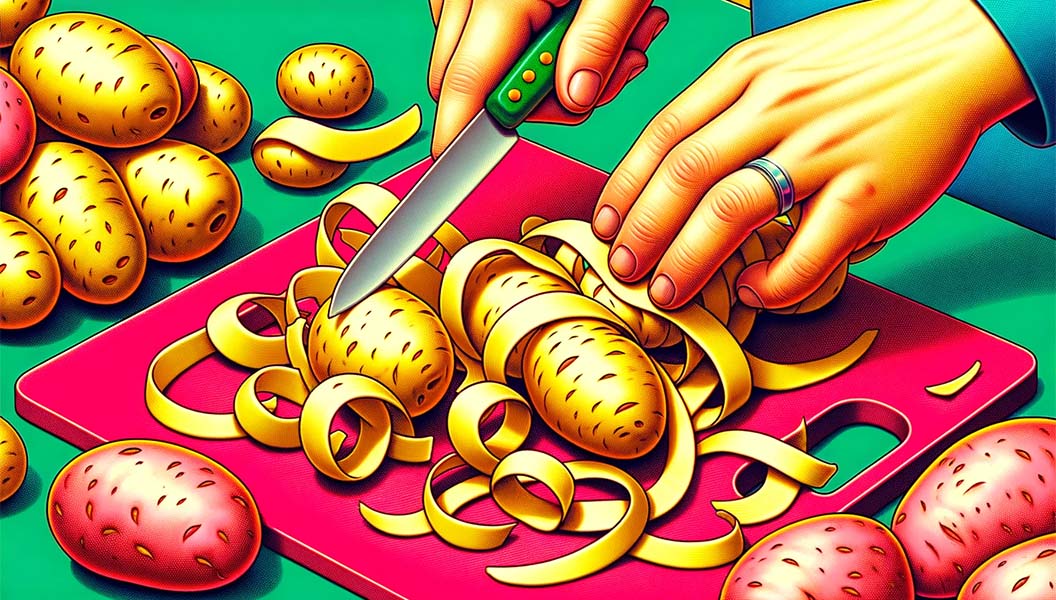Believe it or not, peeling a potato without the traditional potato peeler is possible and can be quite efficient and satisfying. Whether you're in a pinch, looking to improve your knife skills, or simply prefer the rustic feel of a hand-peeled potato, this skill is a valuable addition to your culinary repertoire.
In this guide, we'll explore alternative methods to peel potatoes beyond the conventional vegetable peeler, offering you the flexibility and skill to tackle this task with nothing more than a knife or even your bare hands. From the classic paring knife technique to the innovative boiling method, we'll cover a range of approaches that cater to all skill levels.
Methods To Peel Potatoes Without a Peeler
Boil and Ice Bath Method

The Boil and Ice Bath Method for peeling potatoes is a remarkably efficient technique that simplifies the peeling process and preserves the potatoes' integrity, texture, and flavor. This method involves two primary steps: boiling the potatoes until tender and quickly transferring them to an ice bath. Here's the reason why it proves highly effective.
- Boiling: Begin by boiling the potatoes in their entirety. You don’t need to score or pierce them; just ensure they are clean. The boiling process cooks the potatoes slightly, making them tender but not mushy. The crucial aspect is to monitor the cooking time closely. You aim for the potatoes to be cooked sufficiently to loosen the skins while the flesh remains firm. Typically, this process takes 10-15 minutes, adjusting based on the potatoes' size.
- Ice Bath: Immediately transfer the potatoes to a bowl of ice water after boiling. This sudden temperature change shocks the potatoes, stopping the cooking process instantly. The rapid cooling also causes the skin to contract away from the potato's flesh, loosening it significantly. Place the potatoes in the ice bath until they are cool enough to handle.
- Peeling: Once the potatoes have cooled, you will find that the skins have loosened considerably. At this point, the skins can often be removed simply by rubbing them with your fingers. A gentle pinch should suffice for skins that are a bit more stubborn to make them peel away effortlessly. This method is particularly useful when peeling large potatoes, as it saves time and minimizes waste.
The Boil and Ice Bath Method is not just about ease and efficiency; it also has culinary benefits. By cooking the potatoes gently and stopping the cooking process before they become overdone, this method preserves the natural texture and flavor of the potatoes. It ensures that they remain firm and flavorful, making them perfect for salads, potato dishes that require further cooking, or simply enjoying on their own with a dash of seasoning.
Scoring and Boiling

The Scoring and Boiling technique is a clever and efficient method for peeling potatoes, especially when working with large quantities. This approach involves a simple yet effective pre-boiling preparation that significantly eases peeling. Here's how it works:
- Scoring the Potatoes: Begin by taking each raw potato and scoring a shallow line around its middle circumference. This doesn't mean cutting deep into the potato; a light, surface-level incision is all that's needed. This scoring technique is intended to create a breakpoint in the skin, facilitating easier removal after boiling.
- Boiling: Once all your raw potatoes have been scored, boil them as you normally would. The boiling process cooks the potatoes, and the heat causes the skin at the score line to break apart due to the expansion of the potato flesh.
- Peeling: Remove the boiled potatoes from the boiling water once they are fully cooked. You'll notice that the skin around the scored potatoes has started to separate. Starting from this breakpoint, you can easily peel the skin away with your fingers or with the help of a small sharp knife. The skin typically comes off in two neat halves, following the top and bottom sections created by the scoring line.
The Scoring and Boiling method is ideal for meals requiring peeled potatoes in significant quantities, such as mashed potatoes and potato salads, or when prepping potatoes for canning or freezing. It's a time-saver that doesn't compromise on the quality or taste of the potatoes, making it a favorite technique among home cooks and professional chefs alike.
Baking and Squeezing

This is a clever unpeeled potato approach that simplifies the potato peeling process, particularly when your goal is to prepare dishes like no-peel mashed potatoes. This method requires baking the potatoes until they are fully cooked and soft. After removing them from the oven and allowing them to cool to a manageable temperature but while still warm, you slice each potato in half horizontally.
The magic happens when you gently squeeze each half of the potato over a bowl or pot. The flesh, now soft and fluffy from baking, separates easily from the potato skin and is pushed out, leaving the skin virtually intact in your hand. This method is not only efficient, saving you the time and hassle of peeling potatoes with a knife or peeler, but it also ensures that the full flavor and texture of the potato are preserved and concentrated as baking intensifies both. It’s particularly handy when you're aiming to make mashed potatoes, as it streamlines the process, reducing both preparation time and cleanup. Plus, it offers a rustic, hearty texture to your dishes that is often lost when potatoes are peeled and boiled.
Using a Knife

Peeling potatoes with a knife is a classic technique that comes in handy when you don't have a peeler available. This approach demands greater skill and caution, but with practice, it can prove highly effective. Here's how to do it safely and efficiently:
- Choose the Right Knife: A small, sharp paring knife is ideal. Its size and sharpness give you better control and precision when peeling.
- Hold the Potato Securely: Grasp the potato securely with your non-dominant hand, keeping your fingers away from the blade's path. Holding the potato on a towel or paper towel is helpful to prevent slipping.
- Start Peeling: Begin at one end of the potato, carefully sliding the knife under the potato skins. Aim to remove only the skin and as little flesh as possible. Use a gentle sawing motion if necessary, but try to make the motion smooth and controlled to avoid jagged edges or deep cuts into the potato.
- Rotate and Repeat: As you peel, rotate the potato to work your way around its entire surface. For areas that are hard to reach or irregularly shaped, adjust your grip on the potato and the angle of the knife to maintain control.
- Proceed with Caution: Always peel away from your body and fingers to minimize the risk of accidental cuts. Take your time, especially as you're learning or if the potato is particularly slippery.
- Clean Up: Following peeling, rinse the potatoes under cold water to eliminate any lingering bits of skin or dirt. This step also helps prevent them from browning if not used immediately.
Using a knife to peel potatoes may not be as quick as a peeler, but it offers a satisfying sense of accomplishment and can be a meditative kitchen task once mastered. It's a useful skill that can be applied to other fruits and vegetables, enhancing your overall kitchen proficiency. Remember that practice leads to improvement, so don't feel discouraged if your initial attempts are imperfect. Over time, you'll refine a technique that suits you best.

